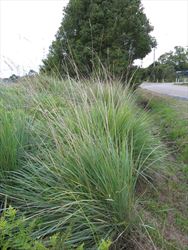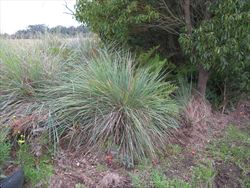Click on images to enlarge

Photo by Harry Rose - flickr.com (CC BY 2.0)

Photo by Harry Rose - flickr.com (CC BY 2.0)

Photo by Harry Rose - flickr.com (CC BY 2.0)
Scientific Name
Paspalum quadrifarium Lam.
Family
Gramineae (South Australia)Poaceae (Queensland, New South Wales, the ACT, Victoria, Tasmania, Western Australia and the Northern Territory)
Common Names
blue grass, giant paspalum, golden-top grass, goldentop grass, paspalum, tussock paspalum
Origin
Native to southern South America (i.e. Brazil, Argentina, Paraguay and Uruguay).
Naturalised Distribution
Naturalised in some parts of eastern Australia (i.e. south-eastern Queensland, some parts of eastern New South Wales and southern Victoria).
Also naturalised elsewhere, including in south-eastern USA (i.e. Mississippi).
Habitat
A weed of warmer-temperate, sub-tropical and tropical regions that is mostly found in disturbed sites, rainforests, closed forests, open woodlands and forest margins.
Habit
A tufted or tussock-forming, upright (i.e. erect), long-lived (i.e. perennial), grass usually growing 0.9-2 m tall.
Distinguishing Features
- a large tussock-forming long-lived grass growing up to 2 m tall.
- its long and narrow leaves have sheaths and blades that are mostly hairless.
- where the leaf sheath meets the blade there is a small membranous structure about 1-4 mm long.
- its seed-heads (10-25 cm long) have many (15-25) branches, each bearing numerous small flower spikelets.
- these flower spikelets are borne in four rows along the seed-head branches and turn golden brown in colour as they mature.
Stems and Leaves
The flowering stems (i.e. culms) are un-branched and hairless (i.e. glabrous).
The leaves are alternately arranged, with a sheath that surrounds the stem, and a long and narrow (i.e. linear) leaf blade (15-70 cm long and 4-9 mm wide). The leaf sheaths are mostly hairless (i.e. glabrous), except near where they meet the leaf blade. At this point there is a small membranous structure (i.e. ligule), about 1-4 mm long, that is surrounded by hairs. The leaf blades gradually taper to a point (i.e. attenuate apex) and are hairless (i.e. glabrous) or sparsely hairy (i.e. puberulent).
Flowers and Fruit
The elongated seed-heads (10-25 cm long) have many (15-25) side-branches (i.e. a panicle of racemes). Each of these branches (i.e. racemes) is 3-10 cm long and bears numerous (50-100) small flower spikelets. These flower spikelets (2-2.8 mm long) are paired on either side of the branch (i.e. rachis), giving the branches a four-rowed appearance. They are oval (i.e. elliptic) in shape with surfaces that are usually slightly hairy (i.e. pubescent). Flowering occurs throughout the year, but is most abundant from spring through to early autumn.
When the seeds are mature, the whole rust-coloured flower spikelet falls from the seed-head entire.
Reproduction and Dispersal
This species reproduces by seed. The seeds are most likely dispersed by water, animals, machinery and other vehicles.
Environmental Impact
Tussock paspalum (Paspalum quadrifarium) is regarded as an environmental weed in parts of New South Wales and as a potential environmental weed in some parts of Victoria. It is also listed as a priority environmental weed in at least one Natural Resource Management region.
This highly invasive species often establishes on road edges and in other disturbed sites, such as along drainage lines. It spreads from these areas into nearby bushland and along waterways. Tussock paspalum (Paspalum quadrifarium) grows in large clumps up to one square metre in size and puts pressure on bushland integrity and native species biodiversity. Once established, it has the ability to form extremely dense infestations that out-compete all other vegetation.
Tussock paspalum (Paspalum quadrifarium) is currently of most concern in the wider Sydney and Blue Mountains, where it inhabits disturbed but un-mown sites of relatively low fertility.
Legislation
This species is declared under legislation in the following states and territories:
- New South Wales: Class 3 - a regionally controlled weed. The relevant local control authority must be promptly notified of the presence of this weed and it must be fully and continuously suppressed and destroyed (in the Ku-ring-gai, Lane Cove, Manly, Mosman, North Sydney, Pittwater, Ryde, Hunters Hill, Hornsby, Warringah and Willoughby local authority areas).
- Western Australia: Unassessed - this species is declared in other states or territories and is prohibited until assessed via a weed risk assessment (throughout the entire state).
Management
For information on the management of this species see the following resources:
- the Ku-ring-gai Council fact sheet on this species, which is available online at http://www.kmc.nsw.gov.au.
Similar Species
Tussock paspalum (Paspalum quadrifarium) is similar to other closely-related grasses, including Vasey grass (Paspalum urvillei), broad-leaved paspalum (Paspalum mandiocanum), paspalum (Paspalum dilatatum), Bahia grass (Paspalum notatum) and scrobic (Paspalum scrobiculatum). These species can be distinguished by the following differences:
- tussock paspalum (Paspalum quadrifarium) is a tall grass (1-2 m tall) with relatively narrow leaves (4-9 mm across). Its relatively small flower spikelets (2-3 mm long) do not have long silky hairs on their margins and its seed-heads usually have 15-25 branches (i.e. racemes).
- Vasey grass (Paspalum urvillei) is a tall grass (1-2.5 m tall) with relatively narrow leaves (4-9 mm across). It has relatively small flower spikelets (2-3 mm long) with long silky hairs on their margins and its seed-heads usually have 10-20 branches (i.e. racemes).
- broad-leaved paspalum (Paspalum mandiocanum) is a low-growing grass (less than 1 m tall) with relatively broad leaves (up to 20 mm across). Its relatively small flower spikelets (2-2.5 mm long) do not have long silky hairs on their margins and its seed-heads usually have only 3-10 branches (i.e. racemes).
- paspalum (Paspalum dilatatum) is a moderately-sized grass (usually about 1 m tall) with relatively narrow leaves (up to 12 mm across). It has relatively large flower spikelets (3-4 mm long) with long silky hairs on their margins and its seed-heads usually only have 3-7 branches (i.e. racemes).
- Bahia grass (Paspalum notatum) is a low-growing grass (usually less than 60 cm tall) with relatively narrow leaves (up to 10 mm across). Its relatively large flower spikelets (2.75-4 mm long) do not have long silky hairs on their margins and its seed-heads usually have only two branches (i.e. racemes).
- scrobic (Paspalum scrobiculatum) is a moderate-sized grass (usually 0.5-1.5 m tall) with relatively narrow leaves (3-12 mm across). Its relatively small flower spikelets (2-2.5 mm long) do not have long silky hairs on their margins and its seed-heads usually have only 2-7 branches (i.e. racemes).

